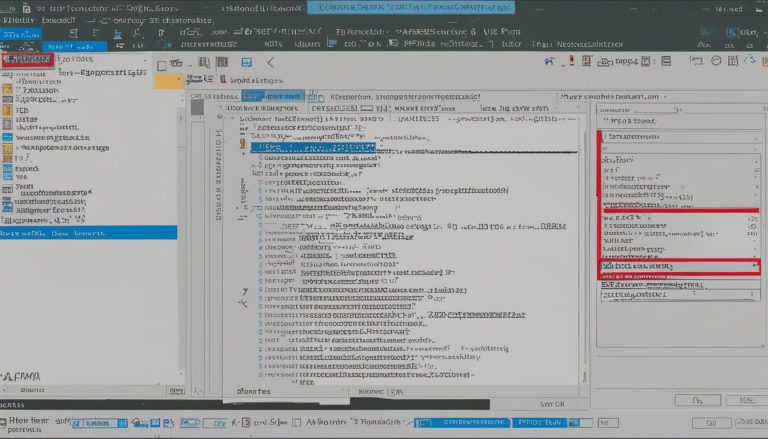As a developer, you’ve probably come across the term “code repository” numerous times. But do you really understand what it is and why it’s important? In this article, I’ll demystify the concept of a code repository and explain its significance in the world of software development.
A code repository is a digital library where developers store and collaborate on their codes with ease. It serves as a code-specific storage platform, allowing developers to trace changes, revert to previous versions, and collaborate with other developers. The main purpose of a code repository is to streamline the coding process and facilitate teamwork.
By using a code repository, developers can edit the same code simultaneously without fear of losing their changes. It also acts as a time machine, allowing developers to undo changes and start over if necessary. Cryptography plays a role in securing code repositories by encrypting data and providing digital signatures for authenticity.
Code repositories are fundamental to cryptocurrency development, allowing global collaboration and innovation. Popular code repository platforms include GitHub, which uses Git as a version control system. Decentralized code repositories, similar to Bitcoin’s decentralized nature, distribute code across multiple nodes for increased resilience and accessibility.
Key Takeaways:
- A code repository is a digital library where developers store and collaborate on their codes.
- It allows tracing changes, reverting to previous versions, and facilitating teamwork.
- Code repositories streamline the coding process and ensure collaboration without conflicts.
- Cryptography secures code repositories by encrypting data and providing digital signatures.
- Popular code repository platforms include GitHub, which utilizes Git as a version control system.
Understanding Source Code Management
Source Code Management (SCM) is a crucial aspect of software development that involves tracking changes to code files in a repository. While often used interchangeably with version control, SCM specifically focuses on managing code projects and facilitating collaboration among developers. The purpose of Source Code Management is to streamline the development process, maintain code integrity, and prevent conflicts.
SCM utilizes a version control system to track changes made to code files over time. This system allows developers to work on the same codebase simultaneously, without the fear of losing their changes or overwriting others’ work. By providing a detailed history of the project’s development, Source Code Management enables developers to revert to previous versions, track bug fixes, and analyze the evolution of the code.
One widely used version control system for SCM is Git. Git is a distributed version control system that provides a robust infrastructure for managing code repositories. With its decentralized nature, Git allows developers to work on codebases independently and then merge their changes seamlessly. By employing Git and other SCM tools, developers can collaborate efficiently, improve code quality, and ensure the success of their coding projects.
| Benefits of Source Code Management |
|---|
| Facilitates collaboration among developers |
| Maintains code integrity and prevents conflicts |
| Tracks changes and provides a detailed project history |
| Enables easy reverting to previous code versions |
| Allows for efficient bug fixing and troubleshooting |
“Source Code Management is the backbone of effective collaboration and version control in software development. It allows developers to work together seamlessly, track changes, and maintain code quality. With the right SCM tools, development teams can streamline their workflow, prevent conflicts, and ensure the success of their coding projects.”
The Role of GitHub in Source Code Management
GitHub is a cloud-based hosting platform that serves as a powerful source code management tool. It provides a centralized hub for storing and accessing Git repositories, making it a popular choice among developers for collaborative coding projects. With GitHub, developers can easily track changes, manage projects, and facilitate teamwork, all within a browser-based interface.
One of the key advantages of GitHub is its integration with Git, a distributed version control system. This allows developers to leverage Git’s features seamlessly within the GitHub platform. By using Git’s version control capabilities, developers can track changes made to code files, revert to previous versions, and effectively collaborate with other team members.
Beyond its primary role in source code management, GitHub is a versatile platform that supports various use cases. It has been utilized for diverse purposes such as travel logging, music composition, and open-source font editing. GitHub’s flexibility and extensive features make it a valuable tool for developers in different domains.
GitHub in Brief:
- Cloud-based hosting platform for storing and accessing Git repositories
- Facilitates source code management, allowing developers to track changes and collaborate
- Integrates seamlessly with Git, a distributed version control system
- Offers a browser-based interface for ease of use and accessibility
- Used for various purposes beyond source code management
| Benefits of GitHub in Source Code Management |
|---|
| Streamlined collaboration and teamwork |
| Efficient tracking and management of code changes |
| Integration with Git’s version control capabilities |
| Browser-based interface for ease of use |
| Versatility for different use cases |
GitHub plays a pivotal role in source code management, providing developers with a powerful platform for collaboration and code tracking. Its integration with Git and browser-based interface make it a valuable tool for managing coding projects effectively. Developers can leverage GitHub’s features to streamline their workflows, track changes, and enhance teamwork, ultimately improving their overall coding process.
The Importance of Source Code Management
Effective source code management (SCM) is crucial for ensuring the success and efficiency of coding projects. By implementing proper SCM practices, developers can streamline their workflow, enhance collaboration, and maintain the integrity of their codebase. Here are some key reasons why source code management is of utmost importance:
- Version Control: One of the primary benefits of SCM is its ability to track changes to code files and provide version control. With SCM, developers have a complete history of their project’s evolution, allowing them to easily review past versions, track modifications, and revert to previous states if necessary. This ensures that any mistakes or bugs can be quickly identified and fixed, saving valuable time and effort.
- Collaboration and Teamwork: SCM facilitates collaboration among developers by providing a centralized platform for sharing and managing code. It allows multiple team members to work on the same project simultaneously, with each individual able to make changes without interfering with the work of others. SCM also enables efficient merging of code changes, ensuring that everyone is working on the most up-to-date version of the project.
- Code Quality and Documentation: By using SCM, developers can enforce coding standards and best practices within their team. This promotes cleaner and more efficient code, enhances code quality, and makes it easier for team members to understand and review each other’s work. SCM also encourages comprehensive documentation, allowing developers to leave detailed comments and instructions about their code, making it easier for future reference and knowledge sharing.
Overall, source code management is an indispensable tool for any development team. It not only simplifies the coding process but also improves collaboration, code quality, and project maintenance. By adopting proper SCM practices and utilizing the right tools, developers can optimize their workflow and achieve greater success in their coding endeavors.
Table: Benefits of Source Code Management
| Benefit | Description |
|---|---|
| Version Control | Track changes, review past versions, and revert if necessary. |
| Collaboration and Teamwork | Enable multiple developers to work together without conflicts. |
| Code Quality and Documentation | Promote coding standards, enhance code quality, and facilitate documentation. |
Benefits of Source Code Management
Source Code Management (SCM) brings numerous advantages to developers and development teams, enhancing their coding process and improving collaboration. By effectively utilizing SCM, developers can streamline their workflow, track changes easily, and ensure code quality.
One major benefit of SCM is having a stored history of a project’s evolution. This allows developers to track changes, review code, and undo changes if necessary. The ability to revert to previous versions provides a safety net, enabling developers to experiment and iterate without the fear of losing their work. It also simplifies troubleshooting and bug fixing, as developers can easily pinpoint when and how issues arose.
SCM also simplifies workflow and increases productivity by automating project maintenance. With SCM, developers can focus on coding and collaborating, while the tool takes care of version control, merging changes, and resolving conflicts. This reduces communication overhead and ensures that everyone is working with the latest code, preventing conflicts and minimizing disruptions to the development process.
SCM provides a standardized process for collaborative development, ensuring consistent practices and preventing conflicts. It promotes better documentation and enables easier code review, enhancing code quality and facilitating knowledge sharing within development teams.
By following SCM best practices, such as standardizing workflow, working from the latest version, and making smaller, frequent commits, developers can make the most of SCM and maximize its benefits. Clear and detailed commit messages, comments, and documentation also contribute to better code understanding and future reference.
Benefits of Source Code Management:
- Easily track changes and review code
- Ability to revert to previous versions
- Streamlined workflow and increased productivity
- Automated project maintenance and conflict resolution
- Standardized process for collaborative development
- Better documentation and code review
- Enhanced code quality and knowledge sharing
Source Code Management is a fundamental aspect of modern software development, providing developers with the tools and processes they need to collaborate effectively, manage code repositories, and ensure code quality. By embracing SCM, developers can streamline their workflow, track changes easily, and enhance their coding process.
Best Practices for Source Code Management
When it comes to Source Code Management (SCM), following best practices is essential for smooth collaboration and efficient development. These practices ensure that the SCM workflow is optimized, changes are committed effectively, and the project history remains manageable. Here are some key best practices to consider:
Standardize the Workflow
Start by defining a clear and standardized workflow for your development team. This includes guidelines on how to use the SCM tool, naming conventions for branches and commits, and procedures for code review and deployment. By standardizing the workflow, you establish consistency and clarity, making it easier for team members to collaborate and understand each other’s contributions.
Work from the Latest Version
Always start your work from the latest version of the code. This helps prevent conflicts and ensures that you’re building on the most up-to-date foundation. Before making any changes, update your local repository to sync with the remote repository. This practice minimizes the chances of overwriting or duplicating code and streamlines the merging process when multiple developers are working on the same project.
Commit Changes Frequently
Make it a habit to commit changes frequently, but in smaller and meaningful chunks. This practice has several advantages. First, it allows for easier code review since the changes are more manageable. Second, it helps create a detailed project history, making it easier to track the evolution of the code over time. Finally, committing changes frequently reduces the risk of losing work in case of unexpected issues or system failures.
By adhering to these best practices, developers can make the most out of Source Code Management, enhancing collaboration, ensuring code integrity, and improving project efficiency.
Summary of Source Code Management
Source Code Management (SCM) is a crucial process for managing collaborative coding projects and facilitating teamwork. It provides a record of a project’s history, allowing developers to easily track changes, review code, and undo modifications if necessary. With SCM, developers can streamline their workflow and automate project maintenance, reducing communication overhead and increasing productivity. The adoption of SCM best practices, such as standardizing workflows and making smaller, frequent commits, further enhances the effectiveness of SCM tools.
GitHub is a popular cloud-based platform widely used as a source code management tool. It serves as a centralized hub for storing and accessing Git repositories, providing a comprehensive solution for managing code repositories. Developers can leverage GitHub’s features, making it easier to collaborate, track changes, manage projects, and review code. Additionally, GitHub’s flexibility extends beyond source code management, with its application in various domains such as travel logging, music composition, and open-source font editing.
In summary, Source Code Management is an indispensable process for developers and development teams. By utilizing SCM tools like GitHub and following best practices, they can efficiently manage code repositories, promote collaboration, and enhance the overall coding process. SCM offers numerous benefits, including easier code tracking, streamlined workflows, and improved code quality. It empowers developers to effectively manage collaborative coding projects, ensuring the success and maintenance of software development endeavors.
| Benefits of Source Code Management | Best Practices for Source Code Management |
|---|---|
|
|
Conclusion
In conclusion, Source Code Management (SCM) is an essential aspect of modern software development. It simplifies the coding process, facilitates collaboration, and ensures code quality. SCM tools like GitHub provide a centralized platform for managing code repositories, allowing developers to easily track changes, collaborate with others, and review code.
By utilizing SCM, developers benefit from an organized workflow, automated project maintenance, and improved team productivity. The stored history of code evolution enables easy tracking of changes, making troubleshooting and bug fixing more manageable. Additionally, SCM promotes code consistency, prevents conflicts, and enhances documentation and knowledge sharing within development teams.
Through following best practices such as standardizing workflow, working from the latest version, and making smaller, frequent commits, developers can maximize the effectiveness of SCM. With its numerous benefits and widespread adoption, SCM has become an integral part of successful coding projects.
FAQ
What is a code repository?
A code repository is a digital library where developers store and collaborate on their codes with ease.
What is the purpose of a code repository?
The main purpose of a code repository is to streamline the coding process and facilitate teamwork.
How does a code repository allow developers to collaborate?
By using a code repository, developers can edit the same code simultaneously without fear of losing their changes.
How does a code repository act as a time machine?
Code repositories allow developers to trace changes, revert to previous versions, and undo changes if necessary.
How does cryptography secure code repositories?
Cryptography encrypts data and provides digital signatures for authenticity, ensuring the security of code repositories.
What are some popular code repository platforms?
GitHub, which uses Git as a version control system, is a popular code repository platform.
What is Source Code Management (SCM)?
Source Code Management is a process and set of tools used to track changes to code files in a repository.
How does SCM differ from version control?
While SCM is often used interchangeably with version control, SCM specifically focuses on managing code projects.
What is GitHub?
GitHub is a cloud-based hosting platform that provides a centralized hub for storing and accessing Git repositories.
How does GitHub facilitate collaboration and teamwork?
GitHub allows developers to collaborate, track changes, manage projects, and facilitate teamwork within its browser-based interface.
What are the benefits of Source Code Management?
Source Code Management brings benefits such as easier code tracking, streamlined workflow, and improved collaboration.
How can developers effectively utilize Source Code Management?
Developers can effectively utilize Source Code Management by adopting best practices such as standardizing workflow and making smaller, frequent commits.
What is the role of Source Code Management in software development?
Source Code Management is crucial for the successful development and maintenance of coding projects.
What is the summary of Source Code Management?
Source Code Management is a process and set of tools used to track changes to code files in a repository, facilitating collaboration and code quality.
Janina is a senior specialist in information technology


